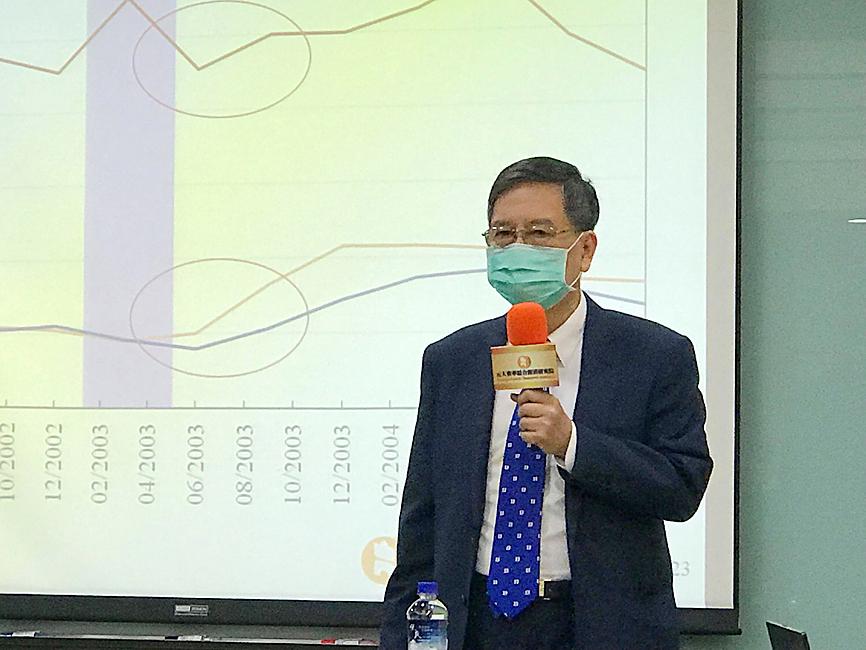The Yuanta-Polaris Research Institute (元大寶華綜經院) yesterday cut its forecast for Taiwan’s GDP growth this year from 2.3 percent to 1.5 percent as the COVID-19 pandemic deals a blow to the global economy with no signs of easing anytime soon.
“The damage caused by COVID-19 is evolving beyond the depths of existing economic models, because health experts around the world do not have a full grasp of the disease yet,” said Liang Kuo-yuan (梁國源), the Taipei-based think tank’s president.
Research institutes at home and abroad are comparing the pandemic to the SARS outbreak of 2003 or the global financial crisis of 2008, but there is no guarantee that the analogies are valid or sound, Liang said.

Photo: Wu Chia-ying, Taipei Times
However, the one thing that is certain is that the virus is quickly sweeping from Asia to Europe, the US and other parts of the world, dimming global trade outlook and chilling consumer activity, he said.
The pandemic encompasses all of Taiwan’s export markets and there is no doubt that exports would take a hit beyond the earlier concerns caused by supply chain disruptions in China, he added.
Diminished market demand has become a reality following travel restrictions and business shutdowns around the world, and a recovery is evasive until the third quarter of this year or beyond, Liang said.
A protracted outbreak would suggest massive business closures and unemployment, he added.
“The chance of a V-shape recovery is as low as a full-blown recession for the time being,” he said, adding that the world is treading a tightrope and the outcome hinges on how fast it can contain the virus.
The think tank’s forecast is lower than the central bank’s 1.98 percent projection last week and the 2.3 percent growth the Directorate-General of Budget, Accounting and Statistics predicted last month.
However, the latter’s forecast came before the virus had spread to Europe and the US, Liang said.
Government expenditure is the only GDP component that would gain momentum amid efforts to shore up struggling companies, he said.
Private investment would hold resilient as firms continue to move production away from China and balance investment risks, he added.
Exports this year are now expected to increase only 1.27 percent, while imports might grow mildly at 1.3 percent, the institute said.
Private consumption might squeeze out a 1.04 percent increase as people cut spending, while the government seeks to lend support, it said.
The decline in oil prices is the only favorable development, which would allow Taiwan to post trade surpluses, Liang said.
The New Taiwan dollar might trade at an average of NT$30.36 against the greenback as the central bank maneuvers to support exports while seeking to avert currency manipulation charges by the US, Liang said.

The New Taiwan dollar is on the verge of overtaking the yuan as Asia’s best carry-trade target given its lower risk of interest-rate and currency volatility. A strategy of borrowing the New Taiwan dollar to invest in higher-yielding alternatives has generated the second-highest return over the past month among Asian currencies behind the yuan, based on the Sharpe ratio that measures risk-adjusted relative returns. The New Taiwan dollar may soon replace its Chinese peer as the region’s favored carry trade tool, analysts say, citing Beijing’s efforts to support the yuan that can create wild swings in borrowing costs. In contrast,

Nvidia Corp’s demand for advanced packaging from Taiwan Semiconductor Manufacturing Co (TSMC, 台積電) remains strong though the kind of technology it needs is changing, Nvidia CEO Jensen Huang (黃仁勳) said yesterday, after he was asked whether the company was cutting orders. Nvidia’s most advanced artificial intelligence (AI) chip, Blackwell, consists of multiple chips glued together using a complex chip-on-wafer-on-substrate (CoWoS) advanced packaging technology offered by TSMC, Nvidia’s main contract chipmaker. “As we move into Blackwell, we will use largely CoWoS-L. Of course, we’re still manufacturing Hopper, and Hopper will use CowoS-S. We will also transition the CoWoS-S capacity to CoWos-L,” Huang said

Nvidia Corp CEO Jensen Huang (黃仁勳) is expected to miss the inauguration of US president-elect Donald Trump on Monday, bucking a trend among high-profile US technology leaders. Huang is visiting East Asia this week, as he typically does around the time of the Lunar New Year, a person familiar with the situation said. He has never previously attended a US presidential inauguration, said the person, who asked not to be identified, because the plans have not been announced. That makes Nvidia an exception among the most valuable technology companies, most of which are sending cofounders or CEOs to the event. That includes

INDUSTRY LEADER: TSMC aims to continue outperforming the industry’s growth and makes 2025 another strong growth year, chairman and CEO C.C. Wei says Taiwan Semiconductor Manufacturing Co (TSMC, 台積電), a major chip supplier to Nvidia Corp and Apple Inc, yesterday said it aims to grow revenue by about 25 percent this year, driven by robust demand for artificial intelligence (AI) chips. That means TSMC would continue to outpace the foundry industry’s 10 percent annual growth this year based on the chipmaker’s estimate. The chipmaker expects revenue from AI-related chips to double this year, extending a three-fold increase last year. The growth would quicken over the next five years at a compound annual growth rate of 45 percent, fueled by strong demand for the high-performance computing